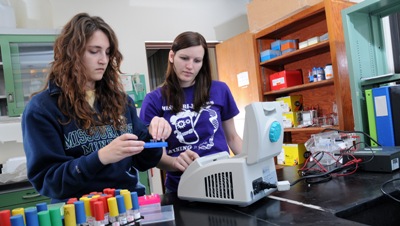A group of students from Missouri University of Science and Technology and the International Genetically Engineered Machine Foundation (iGEM) chapter have developed a biological sensor system, which has utilized DNA segments embedded in bacteria, in order to sense glucose. Diabetic patients may get a new kind of test strip from this recent development.
 Erica Shannon, left, and Amanda Foster, both biological sciences students at Missouri University of Science and Technology, are members of Missouri S&T's iGEM chapter. The group developed a biological system to detect glucose levels, a process that could one day help people with diabetes.
Erica Shannon, left, and Amanda Foster, both biological sciences students at Missouri University of Science and Technology, are members of Missouri S&T's iGEM chapter. The group developed a biological system to detect glucose levels, a process that could one day help people with diabetes.
Erica Shannon, Missouri S&T’s iGEM chapter president and a senior in biological sciences, has said that the DNA was designed in such a way that bacteria containing DNA can detect osmolarity, which refers to the compound concentration, that changes because of glucose presence.
In this project, the genes allowing the bacteria, which is a non-virulent E. coli strain in particular was designed by the students for detecting the existence of the simple sugar glucose. When this bacteria senses glucose, it will emit a yellow glow. This yellow glow will be bright, based on the concentration of glucose.
As said by Shannon, the biological sensor system developed by the team forms new, inexpensive method of sensing glucose in diabetic patients and monitors the level of blood-glucose. The fluorescent gene in bacteria may need one that changes color based on the level of glucose. So, this may lead to the expansion of diabetes blood-test strips, which shows the level of glucose based on different colors.
She added that the test strip can be obtained by putting the DNA inside the bacteria. This kind of strips will be cheap that to create chemical-based test strips. The upcoming research may add an insulin gene to this sensor system for triggering the production of insulin levels.